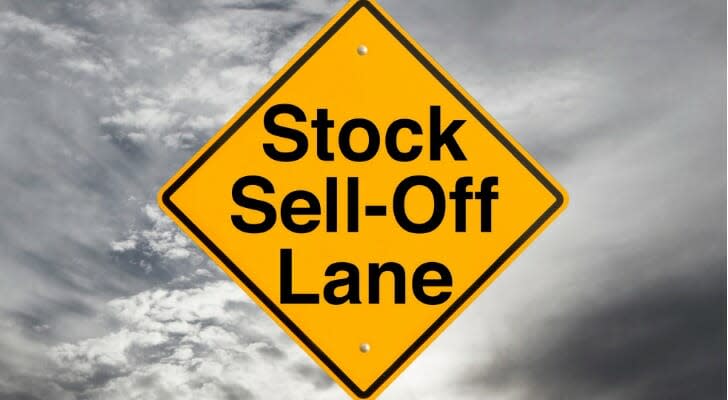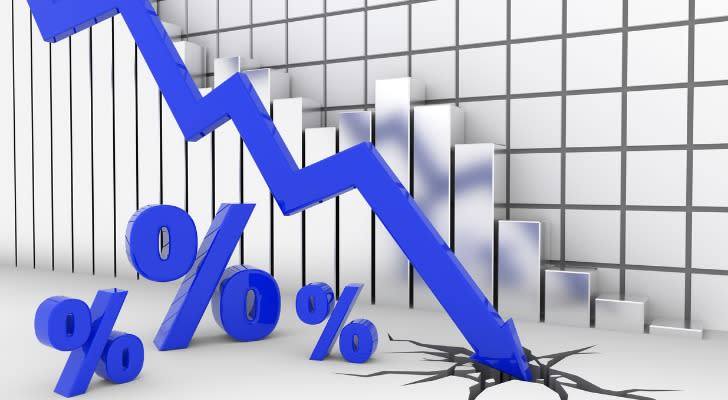Why Market Sell-Offs Happen and How to Respond
A market sell-off happens when traders make a lot of sales very quickly. Sometimes a sell-off, which is a particularly aggressive form of a bear market, can encompass an entire market. Other times it may focus on specific industries or even individual assets. It isn’t always a bad thing when market sell-offs occur. They act as a corrective mechanism, helping investors to reduce prices that have gotten too high. That may come as cold comfort, of course, to investors who lose money. Here’s how they work.
Consider working with a financial advisor as you go through cycles of greed and fear that sometimes buffet the investment community.
What Is a Market Sell-Off
A market sell-off is when investors sell a large volume of securities quickly. There is no formal definition that separates a sudden onset of a bear market from a sell-off. Instead it is a loose term, referring to a period when investors are far more eager to sell than to buy.
A market sell-off can occur in any traded asset and may vary in scope. They can encompass an entire market at once. This is what happens, for example, during stock market crashes. They can also occur more narrowly, applying only to sectors, industries or even individual assets. In that case investors would likely refer to a specific asset’s sell-off. The term “market sell-off” typically refers to when investors sell assets across an entire market.
For example, if investors began quickly selling stocks across the entire stock market or even just the New York Stock Exchange, this would be considered a “market sell-off.” If investors began to quickly unload stocks of XYZ Corp. only, this would be considered an XYZ Corp. sell-off.
Market Sell-Offs Cause Prices to Drop
Market sell-offs virtually always cause prices to fall. As traders sell their securities quickly, the prices of those securities tend to drop equally fast. In fact, market sell-offs often drive prices too low. In the wake of a sell-off is often a period of correction during which prices rebound to some degree.
This is because the price of most securities on an open market is determined heavily by supply and demand.
As the number of traders interested in selling an asset increases, the available supply of that asset rises. For example, if stock market traders begin actively trying to sell their shares, the number of shares available to purchase will rise accordingly.
At the same time, and relatedly, during a sell-off the interested sellers in a market will outnumber the interested buyers. This is the definition of a market sell-off: more people are looking to sell the security than are looking to buy it.
In this environment, bidding mechanics tend to kick in. The buyers who are already interested can lower their offering price, because the rising supply means they can keep shopping if one seller rejects their offer. Meanwhile, the lack of buyers overall means that sellers have to drop their asking price until they lure new buyers into the market, since they can’t sell their asset without someone to buy it from them.
The resulting dynamic pushes prices lower until the buyers and sellers in the market reach an equilibrium. Prices stabilize once the sellers regain their bargaining power relative to buyers.
This is an often overlooked reality of markets. At all times, buyers and sellers are two sides of the same coin. Every time someone sells an asset another trader has bought it, and vice versa. So when we say that during a selloff there is a surge in traders selling an asset, this means the number of traders initially offering the asset for sale rises. Buyers accept that offer, but they are responding to the surge in supply caused by traders looking to sell. During a market rally the opposite occurs. There is a surge in traders looking to buy an asset. Sellers enter the market to meet that demand, but the initial interest comes from the buyers.
For example, say that the stock market entered a sell-off. This would mean that marketwide, far more people were looking to sell their stocks than were looking to buy them. In this environment, the buyers would have the upper hand. As someone looking to buy stocks, you could bid down the price of any given asset because for any seller who rejected your offer there would always be another investor with excess shares to sell.
At the same time, as someone looking to sell stocks you would be constantly looking for someone willing to buy them. You might keep dropping your asking price hoping to attract new buyers, investors who were not initially looking to buy stocks may be lured in at your new, lower, prices.
What Causes Market Sell-Offs?
Like most shifts in the market, a sell-off generally takes on a life of its own. As investors begin to sell their assets, the price tends to fall. This causes other investors to jump in, hoping to avoid taking losses now that prices have begun to shift. These sellers spook still others, and the cycle becomes self-perpetuating. A market sell-off can be caused by any number of factors. Often it will be linked with bad news about the underlying asset. For example, if a company or an industry reports an unprofitable quarter, it may trigger a sell-off of the related stock. A bad weather prediction may trigger a sell-off of commodities related to that part of the world, or political turmoil may drive a sell-off in a nation’s currency.
In these cases, some event or news has caused traders to re-evaluate the fundamental value of their holdings. They trade until the value of this security reaches a level that they believe is stable.
However, just as often a sell-off will be triggered by what is known as a “market correction.” This is when prices fluctuate not because of changes to the underlying assets but rather in response to the price of securities themselves.
During a bull market, increases in buying tend to push prices ever higher. Securities get more valuable, which pulls in buyers who want to share in that value. Eventually the price of a security will grow beyond the value of the underlying asset. (In extreme cases this can be known as a “bubble.”) When that happens, at some point investors begin selling off their overvalued assets, pushing prices down to a better reflection of fair market value.
For example, investors may evaluate the “fair” price of stock in XYZ Corp. at $10 per share. This would reflect the likelihood of dividends and other investor payouts, the strength of the company’s business model, likely future profits, its current assets, etc. If the price of XYZ Corp. began climbing to $12 and then $14 per share, it would become less and less profitable to hold over the long run. As a long-term investor you wouldn’t get your money back out of that investment. Eventually, instead, investors would begin selling it off, hoping to capture this inflated value.
How to Use a Market Sell-Off
There are three rules in a market sell-off:
Don’t panic. Don’t panic. And don’t panic.
The truth is, it is impossible to reliably, accurately predict market sell-offs. Some investors get lucky and spot things coming. Others do manage to accurately identify overvalued markets and trade appropriately at individual moments. However, as a general rule, every investor is trading with the same information. If the conditions for a market sell-off are clear in advance then traders have generally already priced that into their investments. Prices will have gradually declined in response to this widely available information, making a sell-off unlikely.
Generally speaking, the conditions for a sell-off are much clearer in hindsight than forecasting. Instead, the best thing you can do to prepare for a market sell-off is to invest for the long term.
During a market sell-off, you want to hold your assets. If it all possible do not join in the frenzy of selling because the wild swings that characterize a sell-off tend to push prices abnormally low. Hold your securities through the sell-off and wait until trading has normalized before you consider selling an asset, otherwise you risk taking unnecessary losses.
In fact, more than anything else, a market sell-off is an ideal time to buy. During this event prices will tend to fall quickly. This makes it an ideal time to purchase assets that have likely become temporarily undervalued. This strategy is known as “trading against the market,” and as long as you have built an investment plan that lets you hold your position through short-term fluctuations it can be extremely worthwhile.
That doesn’t mean you should buy into bad assets. If a company’s stock is in free-fall after reports that it has a bad product or poor leadership, then let it go. But if the stock market has entered a general downturn, take a look at your cash on hand.
Sell-offs may not be predictable, but they can be profitable.
The Bottom Line
A market sell-off occurs when investors sell their positions widely and quickly. Prices fall until trading stabilizes, at which point investors can expect trading to normalize again. Such events may be blessings in disguise as they can afford investors the opportunity to pick up securities at a bargain. On the other hand, they can mark the onset of a secular bear market that strains the patience of even the most committed buy-and-hold investor.
Tips on Investing
How should you respond when the market turns on you? What’s the right move during a period of falling prices and selling stocks? The best place to turn for those answers is a financial advisor. Finding one doesn’t have to be hard. SmartAsset’s matching tool can help you find a financial advisor in your area to help you plan for the good markets, the bad, and everything in between. If you’re ready, get started now.
The stock market can be volatile. While it’s important to watch it for patterns, you can take hands-on measures to guard your finances. For example, an asset allocation calculator can help you create and maintain a diversified portfolio that will help buffer your portfolio as the market goes through bullish and bearish phases.
Photo credit: ©iStock.com/MCCAIG, ©iStock.com/Onypix, ©iStock.com/bankrx
The post Why Market Sell-Offs Happen and How to Respond appeared first on SmartAsset Blog.



